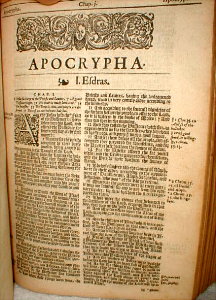 Continued from part 3 27 in the New, over a period of about 1,500 years. So how is it that all these 66 books ever got together in the Bible?
Continued from part 3 27 in the New, over a period of about 1,500 years. So how is it that all these 66 books ever got together in the Bible?
LUTHER AND JAMES
Early on in his ministry, Martin Luther had a problem with the Epistle of James. Luther, standing against the known world with the revelation of sola fide or justification by faith alone, encountered many in the Roman Catholic Church quoting the book of James to dismiss him. Luther, for some time could not reconcile James’ words in chapter 2 of his epistle, with Paul’s clear words in Romans and Galatians. He concluded that James was merely “an Epistle of straw.”
This has led some to argue that Luther did not believe that the Bible was inspired by God, for, they say, how could he believe the Bible is the Word of God and then say that the book of James was a “strawy Epistle?”
Yet these folk confuse a couple of issues that need to be distinguished carefully.
If anyone believed in the inspiration and authority of Scripture, is was Luther (remember Worms!!). He said, “The Scriptures never err!”
But there was a period in his life (though he changed his mind later) when he had real questions about James. But this is the point we need to see Luther’s question was not about whether the Bible was inspired, but whether the Epistle of James is supposed to be included in the Bible.
Can you see the important difference?
For Luther, the entire Bible is inspired. However, he was asking a question concerning which are the right books to be included in the Bible, and he had doubts over whether the Epistle of James should have that kind of a status.
This is the question of the Canon of Scripture, or what we refer to as Canonicity.
The word canon comes from the Greek word canon and means “a measuring rod, ruler, norm, or standard by which other things are measured or judged.”
 THE APOCRYPHA
THE APOCRYPHA
You may have wondered why the Roman Catholic Church includes books in their “canon” that are not in our Protestant Bibles. They include books written in the Intertestamental Period (the 400 years between Malachi and Matthew in our Bibles). These are known as The Apocrypha.
Protestants have not included the books of the Apocrypha in the canon. These are regarded as Deuterocanonical books or books on a secondary (deutero) level to Scripture.
It was not until 1546 at the Council of Trent that the Roman Catholic Church officially declared the Apocrypha to be part of the canon (with the exception of 1 and 2 Esdras and the Prayer of Manasseh). It is significant that the Council of Trent was the response of the Roman Catholic Church to Martin Luther and the Protestant Reformation because the books of the Apocrypha contain support for Catholic doctrines such as prayers for the dead and justification by faith plus works.
It is important to remember four further things about the Apocryphal books:
(1) They do not claim for themselves the same kind of authority as the Old Testament writings.
(2) they were not regarded as Scripture by the Jewish people (from whom they originated).
(3) they were not considered to be Scripture by Jesus or the New Testament authors.
(4) they contain teachings that are inconsistent with the rest of the Bible.
THIRD COUNCIL OF CARTHAGE (397 A.D.)
In Church history, the first Council that determined which books made up the Biblical canon met in Carthage, approximately 365 years after the death of Christ.
By way of background, a heretic named Marcion produced the first canon. However, he was heavily influenced by the Gnostics and hated the God of the Old Testament, believing Him to be a different god than the one revealed in the New Testament. In his canon, he only included books that seemed to agree with him. Out would go books like Matthew, because there were far too many quotes from the Old Testament!
This crisis of a heretic’s canon forced the Church to draw up a list of the true books of the New Testament. Even this does not suggest that the Church did not have a Bible up until then.
There is no doubt that, for example, when the Apostle Paul wrote Romans, and it circulated in the Early Church, it was recognized as the Word of God. As the believers at the end of the First Century (sometimes referred to as the Sub-Apostolic Fathers) quoted from the writings of the Apostles, from the Gospels, from Paul’s writings, etc., they quoted them as full biblical authorities. So we know as a matter of historical record that the bulk of the New Testament literature found in our canon functioned as sacred Scripture from the very beginning. That is very important to remember.
Concerning the vast majority of New Testament books, there was never any question in the mind of the Church as to whether or not they belonged in the canon. But there were a few books about which there were questions: Jude, 2 Peter, 1, 2, & 3 John, and Hebrews.
AROUND 2,000 PRETENDERS
There were around 2,000 books/letters circulating that were pretenders, yet we have only 27 of them in the New Testament. How do we know that the right books got into our Bible? How do we know that we have the right 27?
Well, of these 2,000 books, there were only ever 2 (or perhaps 3) that were ever given any serious consideration for inclusion in the canon. The Shepherd of Hermas was one, and First Clement was another.
These were magnificent literature and contained no false doctrine. The reason these were not included is because the authors themselves indicate a clear difference in the authority with which they were writing and that of the Apostles. In other words, they disqualified themselves from inclusion.
The other 1998 or so were never given the time of day, so to speak, because they were Gnostic frauds and everybody knew it.
Is it possible that we have a book in the New Testament that shouldn’t be there? Yes, it is possible.
Is it possible that there were books that were written that didn’t get into the canon that should have? Yes, it is possible.
What is the probability?
Not 1 in 10,000,000,000,000 chances.
There was no work of the Church in Council in the history of the Church about which I have more confidence than that the Church made the correct decision as to which books should be in the canon. It was extremely clear and was not a difficult task.
THREE CRITERIA FOR CANONICITY (basically)
The Council asked:
1. Was this book written by an Apostle or endorsed by an Apostle?
(Mark was not an Apostle, but was Peter’s secretary. The Gospel of Mark could be described as Peter’s Gospel, if you will. Likewise, Luke, who wrote both the Gospel of Luke and the book of Acts, was not an Apostle, but had the endorsement of Paul. Luke was the companion of Paul on many of his missionary journeys).
2. Was this book recognized by the Early Church as Scripture from the very beginning?
3. If a book met these first two criteria (which ruled most out, of course), and there was any question about a book (like Jude or 2nd Peter) the question then was: “Does this book contain anything in it that contradicts the rest of the New Testament (about which there is no question as to canonicity)?” This was the question of conformity to Biblical doctrine.
Under the Providential hand of God this was a very thorough process, and one I don’t believe any Christian needs to be concerned about. I certainly have lost no sleep at all over it!
We have every reason to believe with the fullest possible confidence that the right books, by the grace of God, have been delivered safely through the ages, to the Church today.
For further insight and discussion on this theme I highly recommend the article “Is Sola Scriptura a Protestant Concoction? A Biblical Defense of Sola Scriptura” as well as this article for more information regarding the Apocrypha. Both articles are by Dr. Greg Bahnsen.
